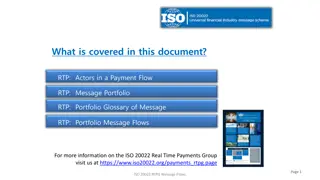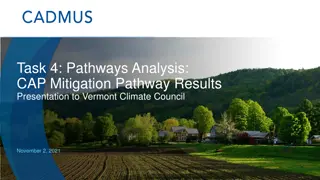
Sensitivity Analysis for System Conditions Impact Study
Explore the purpose, requirements, assumptions, and methodology of sensitivity analysis conducted in the 2017 RTP TPL to assess the impact of varying system conditions on reliability standards. The study delves into scenario specifications and assumption details for different study years, focusing on factors like load levels, transfers, generation scenarios, and reactive resource capability.
Download Presentation

Please find below an Image/Link to download the presentation.
The content on the website is provided AS IS for your information and personal use only. It may not be sold, licensed, or shared on other websites without obtaining consent from the author. If you encounter any issues during the download, it is possible that the publisher has removed the file from their server.
You are allowed to download the files provided on this website for personal or commercial use, subject to the condition that they are used lawfully. All files are the property of their respective owners.
The content on the website is provided AS IS for your information and personal use only. It may not be sold, licensed, or shared on other websites without obtaining consent from the author.
E N D
Presentation Transcript
2017 RTP TPL Sensitivity Analysis
Overview Purpose Protocol Requirements Scenario Specifications Assumption and Methodology
Purpose and Protocol Requirements The purpose is to study the impact of varying one or more of the system conditions as listed in R 2.4.3 of NERC TPL-001-4 reliability standards. Requirement 2.4.3 of NERC Standard TPL-001-4 states: 2.4.3. For each of the studies described in Requirement R2, Parts 2.4.1 and 2.4.2, sensitivity case(s) shall be utilized to demonstrate the impact of changes to the basic assumptions used in the model. To accomplish this, the sensitivity analysis in the Planning Assessment must vary one or more of the following conditions by a sufficient amount to stress the System within a range of credible conditions that demonstrate a measurable change in performance: Load level, Load forecast, or dynamic Load model assumptions. Expected transfers. Expected in service dates of new or modified Transmission Facilities. Reactive resource capability. Generation additions, retirements, or other dispatch scenarios. 3 PUBLIC
Assumption and Methodology Sensitivity analysis will be performed on summer peak base cases for 2019 (year 2) and 2022 (year 5) and an off-peak case for 2020 (year 3) All assumptions and performance criteria will be held consistent with the 2017 RTP scope and process document 4 PUBLIC
Scenario Specifications Condition Region Variable Study years All regions Dispatch: Wind and Hydro units in all weather zones will be modeled offline (None in East and Coast weather zones) (Units will be taken completely out of service, including reactive support) Dispatch and Demand: Wind generation dispatch is increased with a moderate change in system wide demand to simulate HWLL conditions 2019, 2022 Summer peak All regions 2020 Off-peak 5 PUBLIC
Assumptions No Wind No Hydro for Summer Peak Cases All hydro units in each study region are turned off in the respective base cases The table below summarizes the status of wind units for each study region Region South/South Central/East/ Coast North/North Central/West/ Far West Wind Units Offline Wind Units Online Wind units in South and South Central zones Wind units in West, Far West, and North zones Wind units in West, Far West, and North zones Wind units in South and South Central zones 6 PUBLIC
Assumptions No Wind No Hydro for Summer Peak Cases The following table summarizes the change in dispatch (MW of wind and hydro generation being turned off) resulting from the sensitivity Wind (MW) in RTP Cases Hydro (MW) in RTP Cases Year EC NNC WFW SSC EC NNC WFW SSC 2019 - 492 307 726 - 124 92 228 2022 - 492 307 726 - 124 92 228 7 PUBLIC
Assumptions High Wind Low Load for Off Peak Cases Wind Use the historical capacity factors for wind units based on top 20 high wind conditions for each zone: 91.9% capacity factor for PANHANDLE 63.6% capacity factor for SOUTH (COASTAL) 92.6% capacity factor for WEST and NORTH Applying the historical capacity factors, the dispatchable wind in the HWLL case is approximately 12,872 MW 8 PUBLIC
Assumptions High Wind Low Load for Off Peak Cases Load The load level was determined by reviewing historical load levels during top wind hours The following table summarizes the change in dispatch and demand resulting from the sensitivity 2017 RTP Min Case Load (MW) 2017 RTP HWLL Case Load (MW) Year 2020 33,692 37,938 9 PUBLIC






















